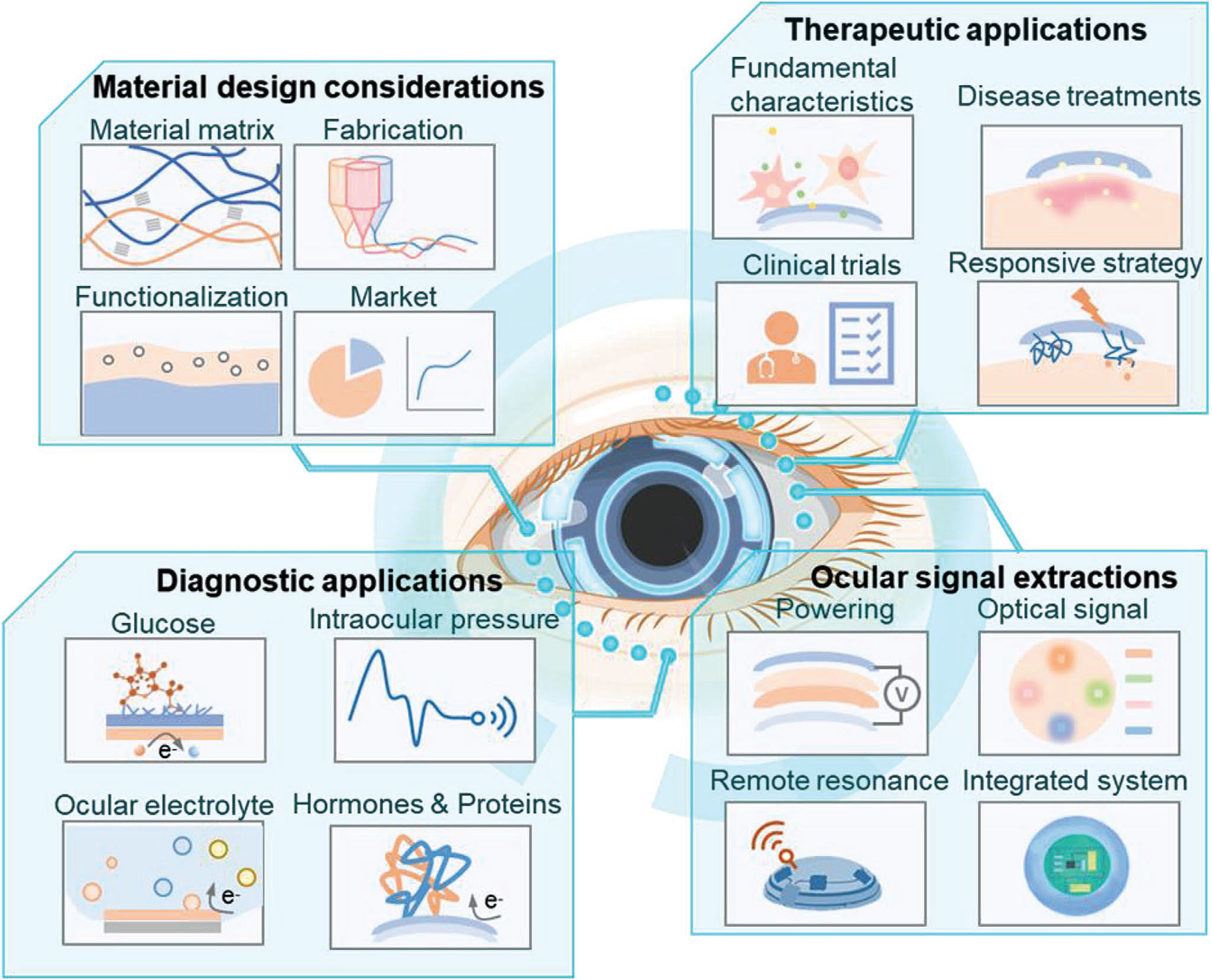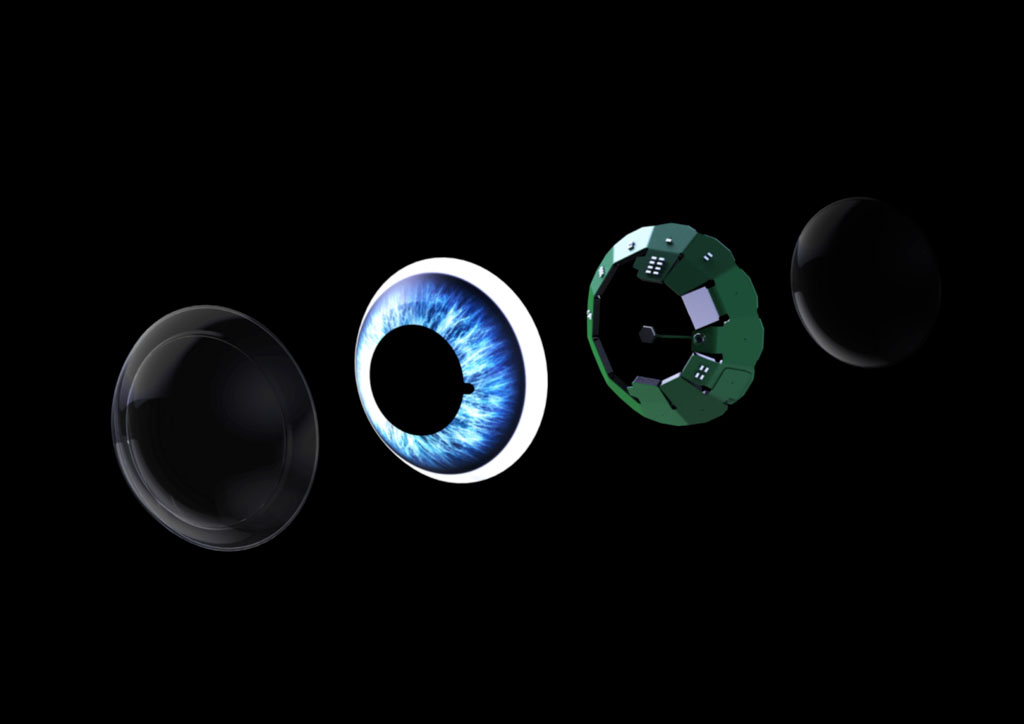| Apr 18, 2022 | |
The future of contact lenses - lab-on-a-lens, augmented reality, and head-up displays |
|
| (Nanowerk Spotlight) What makes contact lenses so attractive for the development of all kinds of biosensors is the fact that they swim on a film of tears – and tear fluid, along with sweat and saliva, has tremendous potential for noninvasive monitoring biological signals because it contains a wide variety of physiological indices such as proteins, glucose, and pH. | |
| As a source for monitoring biosignals, tears have the advantages of easy access, low complexity of sampling, and minimal invasiveness, thus providing an on-demand supply for continuous and real-time health monitoring. | |
| Researchers have already demonstrated biosensor contact lenses using nanomaterials to monitor glucose with transparent transistors and with graphene for diabetic and glaucoma diagnosis. | |
| Previously we also reported on various research projects to develop contact lenses as smart electronic sensor devices for various point-of-care monitoring and wireless biomedical sensing. One recent example has been long-term continuous glucose monitoring with smart contact lenses based on bimetallic nanocatalysts immobilized in nanoporous hydrogels. | |
 |
|
| Ultrathin MoS2 transistor-based smart contact lens to monitor glucose levels. Research: doi: 10.1016/j.matt.2020.12.002. (Reprinted with permission from Cell Press) | |
| Along with the rapid progress and miniaturization of wearable bioelectronics, numerous efforts have been made to develop smart contact lenses (SCLs) that sense through the tear fluid. Especially after Google’s announcement of the smart contact lens project in 2014 has worldwide research interest on SCLs increased. | |
| These SCL studies range from biosignal detection (intraocular pressure, glucose, cortisol) to therapeutic tools (aniridia, chronic ocular inflammation). In addition, multidisciplinary research is continuing to develop advanced SCLs with various attributes such as sensitivity improvement, wireless signal transmission, and personalized design using 3D-printing technology. | |
| Some of these technologies are already finding their way from the lab into commercial applications. The start-up Mojo Vision drew attention in 2020 as it introduced the first SCL concept that could demonstrate data display based on augmented reality (AR) technology. The company's smart contact lens features a tiny microLED display the size of a grain of sand to share critical information, and smart sensors powered by solid-state batteries built into a scleral lens that also corrects your vision. | |
| In addition to diagnostic biosensor applications, contact lenses are an attractive delivery platform for medication to treat eye diseases. For instance, one project has demonstrated a drug-dispensing contact lens that delivers glaucoma medication continuously for a month. Even more promising, the first clinical trial investigating LLT-BMT1, a drug-eluting contact lens from MediPrint Ophthalmics, has been shown to be safe and well-tolerable for the treatment of glaucoma. | |
 |
|
| Lab-on-a-contact lens. A wearable smart contact lens platform integrated with flexible power transfer systems is employed to wirelessly monitor physiological signals (intraocular pressure, corneal temperature, and pH), biomarkers (glucose, proteins, ions, and virus), and controlled drug release in diagnostic and therapeutic applications. (Reprinted with permission from Wiley-VCH Verlag) | |
| Despite these promising prospects and expectations of smart contact lenses, there remain problems to be solved with regard to commercialization – transparency (opaque electronic material), reliability (scalability, repeatability), biocompatibility (rigidity, size, irritation), and underlying side effects that may occur, such as dry eye syndrome. | |
| An excellent recent review article in Advanced Materials ("Lab-on-a-Contact Lens: Recent Advances and Future Opportunities in Diagnostics and Therapeutics") provides a comprehensive overview of recent progress and future opportunities for the use of SCLs for diagnostic and therapeutic applications. | |
| The authors begin by reviewing materials and manufacturing methods for smart contact lenses, followed by an extensive discussion of SCLs as an effective diagnostic tool to sense biosignals from the eye or tear fluids. Then they summarize SCLs for therapeutic applications, including typical characteristics and responsive strategies and, offer an outline of current marketable therapeutic SCLs and examples under the clinical trials. | |
| With an eye on next-generation wearable sensor platforms, they provide a summary of wearable powering systems and wireless transmission technologies, and highlight representative examples for the next generation of SCL wearable platforms. | |
| Looking ahead, there are several challenging and untapped opportunities that provide ample room for future development into multiple research areas, characterized by six significant aspects: | |
| 1) Novel SCL materials with extraordinary properties such as materials with antibiotics, supreme wettability, and appropriate temperature tolerance. | |
| 2) SCL with brand-new functionalities. Next-generation lenses are expected to integrate multiple sensing modal components – such as vital physical signs and metabolites in tear fluid – to achieve precise medical care. Besides the role for biosensing, researchers envision optical & electrical communications, visual stimulation, and even recording and augmented reality (AR) to be achievable by incorporating electrically conductive coatings or applying intrinsic conductive contact lens materials. | |
| 3) SCL platform via wireless power. Current power supplies for powered contact lenses have significant limitations with regard to size and long-term operations. Here, a wirelessly flexible rechargeable battery or supercapacitor with an overall size and power density commensurate with potential SCL applications should is expected to be developed. Another futuristic option is a contact lens with integrated micro solar cells – something researchers already are working on. | |
| 4) Intelligence and programmability of SCL diagnostic and therapeutic platforms. The integration of artificial intelligence (AI) technologies into the control module is appealing for SCL systems, such as automatically controlled drug release. Moreover, AI algorithms can collect long-term data from contact lens biosensors and then transform them into scientific and clinically meaningful information to classify human health conditions and diagnose ocular abnormalities and diseases. Furthermore, the AI-enabled SCL platform can get feedback from the built-in sensor module of the lens, eventually achieving closed-loop and autonomous control. | |
| 5) Bench-to-bedside translations and commercialization. Representative examples that have been successfully commercialized with various design philosophies are already available: usage for monitoring glucose level (e.g., Google Lens project) and detecting intraocular pressure (e.g., Sensimed Triggerfish); incorporation of AR (e.g., Mojo Vision, InWith) and head-up display (e.g., Innovega's eMacula®); achievable drug delivery (e.g. OcuMedic). | |
 |
|
| Mojo Lens’ revolutionary design uses a tiny microLED display the size of a grain of sand to overlaying digital information onto a regular viewfield, and smart sensors powered by solid-state batteries built into a scleral lens that also corrects your vision. (Image: Mojo Vision) | |
| 6) During the COVID-19 pandemic it has been highlighted that the eye can be a possible route of transmission for the SARS-CoV-2 virus (as well as for other viruses). Although there are few reports of the use of therapeutic contact lenses to combat COVID-19, the possible use of SCL to serve as a drug dissolution device in viral diseases such as COVID-19 may present a future development opportunity. | |
| As the above examples have shown, the development of next-generation, smart contact lens technology is not just simply one field of bioelectronics but rather a complex, interdisciplinary effort that includes development of biocompatible materials; development of intuitive interfaces; and development of integration technologies capable of smart contact lens research. | |
 By
Michael
Berger
– Michael is author of three books by the Royal Society of Chemistry:
Nano-Society: Pushing the Boundaries of Technology,
Nanotechnology: The Future is Tiny, and
Nanoengineering: The Skills and Tools Making Technology Invisible
Copyright ©
Nanowerk LLC
By
Michael
Berger
– Michael is author of three books by the Royal Society of Chemistry:
Nano-Society: Pushing the Boundaries of Technology,
Nanotechnology: The Future is Tiny, and
Nanoengineering: The Skills and Tools Making Technology Invisible
Copyright ©
Nanowerk LLC
|
|
|
Become a Spotlight guest author! Join our large and growing group of guest contributors. Have you just published a scientific paper or have other exciting developments to share with the nanotechnology community? Here is how to publish on nanowerk.com. |
|
